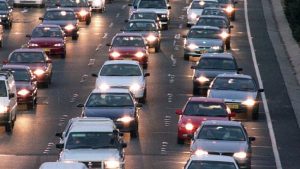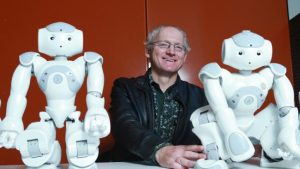

News
Q-Free’s input on autonomous vehicles in The Australian
Autonomous and human-driven cars will have to co-exist for some time. It’s late at night and I’m driving down a dirt back road in Tasmania at the age of 20 with three of my mates in a tinny Ford Laser. We’re doing about 80km/h when suddenly a possum appears and it stands frozen in the middle of the road, its startled eyes shining bright red as it stares straight into the headlights.

There’s no time to brake. As I begin to swerve to miss it, my mate Mikey, one of the smartest people I know, lurches forward from the back seat and speaks directly into my left ear: “Kill it, kill it, kill it,” he orders.
With less than a second up my sleeve, I straighten the car and aim directly at the possum, killing it instantly as its head smashes against car’s undercarriage.
Mikey didn’t want me to kill the possum for the hell of it. Rather, he saw in a split second the danger of me swerving and possibly plowing into a tree or rolling the car, endangering four young lives.
Not everyone makes the right call, especially during this annual holiday season. Far too many drivers end up swerving and dying on our roads.
This year our national road toll is approaching 1300 deaths, up on last year. But it is not an exaggeration to say we could see the holiday road toll end during our lifetime. The reason? Driverless cars.
The potential to slash the road deaths through automation is a reality. Already, some cars, equipped with semi-autonomous braking and steering are safer, but if we go all the way to fully autonomous cars, experts say, the toll could be slashed by 90 per cent.
The advice Mikey gave me that night is directly relevant to this bold new era of driverless cars.
While autonomous cars won’t have Mikey sitting in the back seat, they will be programmed to behave in exactly the same way.
But this throws up an ethical challenge. What if, instead of a possum on that back road in Tasmania, it had been a person? The computer might be programmed to run down a mother with a stroller, a child chasing a ball or an old person crossing the road, to protect the lives in the car.
This ethical dilemma is known as the “trolley problem” in academic literature. It refers to a series of hypothetical scenarios developed by British philosopher Philippa Foot in the 1960s. In these scenarios, people are asked whether they would sacrifice one life to save the lives of others who are standing in the path of a runaway tram.
Toby Walsh, a professor of artificial intelligence at the university of NSW and innovation group Data61, says the era of driverless cars will be a boon for ethicists. Programmers aren’t explicitly writing code to determine which people should be saved in these situations, he notes, but he acknowledges that these decisions will be made implicitly.
“There is no part of the code that has a conditional statement that says if there are fewer people in the car than on the pavement, don’t drive on to the pavement. But somehow the car will behave by following its other rules, which mean it makes an implicit choice, not an explicit choice.
“It is probably going to be a golden age for ethicists to force us to formalise things that have never been written down formally before.” That dilemma aside, the bottom line of this new technology is it will save lives. Automated systems being installed in cars, such as lane-keep assist, autonomous emergency braking and adaptive cruise control, will prevent crashes, the Transport and Infrastructure council says. Alone, autonomous emergency braking is estimated to prevent 20 per cent to 40 per cent of certain crashes.
“In the future, higher levels of automation, including vehicles that require no human control, may significantly reduce the number of road deaths, potentially by as much as 80 or 90 per cent,” says the council, made up of federal, state, territory and New Zealand transport ministers.
Walsh predicts the transition to driverless cars will be as big a jump as that from horse-drawn vehicles to motor cars in the first half of the 20th century. And it could happen much faster than we anticipate. But the transition will be difficult as the two types of technologies — cars with drivers and those without — interact.
Already, self-driving cars are licensed to operate in Singapore and Pittsburgh, and 20 companies in California have approval to test these vehicles.
“We will look back in 20 years’ time and the era of human-driven cars will look like the wild west,” Walsh says.
“In 1950 imagine what it was like to look back 50 years earlier to the turn of 20th century before most of us had motor cars. It is going to be the same in the next 50 years. We are going to look back, we will all be sitting in autonomous cars, many of us won’t be able to drive, and it will look as archaic as the horse-drawn era did to people in 1950.”
Another way of looking at this brave new world is through the experience of aeroplanes. When they were first introduced it was anything goes, but new protocols and autopilot gradually came in and made the skies safer.
“There is a very good historical precedent here, which is aircraft,” Walsh says.
“In the beginning it was the wild west, anything goes, but we quickly worked out some very strict rules to make it now by far the safest means of transport. Most of the time it is the computer flying the plane, and when the landing is soft it’s when it was the computer,” he adds.
Norwegian firm Q-Free is trialling road safety technology in Victoria. Chief technologist Knut Evensen says automated vehicles will be able to react much more quickly and rationally in these tricky situations.
“The only difference between a human driver and a machine driver is the speed and accuracy of perception and reaction, and the machine wins that one easily,” Evensen says.
“The machine will always receive information from its sensors and surroundings one bit at a time, and react to each incoming bit in a rational, predictable way.
“This is exactly what people also do, but we are much worse at being diligent; our perception isn’t all that good, and we often make irrational decisions in critical moments.
“So luckily we don’t have to program the machine to make judgments about which group of people is less valuable, just as this isn’t being taught in driving schools. We only have to program how to drive safely and avoid hitting anything.”
But while the end point may be much safer, the transition from today’s free-for-all to a more orderly, computer-controlled world is going to be very bumpy indeed, Walsh says.
“Ninety-five per cent of accidents are caused by driver error, so the quicker we get the human out of the loop the better. I am just a little concerned about how we are going to get there, especially in that period of transition when there is a mix of autonomous and nonautonomous cars trying to interact together,” he says.
Several of the accidents involving Google cars have occurred because the vehicle has pulled up too quickly when traffic lights have switched from green to amber. Tesla vehicles have been so focused on the car in front they have failed to allow for merging traffic. Walsh says the technology companies are in fact doing whatever they want, which is also making the roads more dangerous as well.
This was demonstrated this month when Uber defied state authorities and put its driverless cars on the roads of San Francisco, only to find two of them ran red lights. The traffic regulator ordered Uber to take its cars off the road.
Police visibility crucial to crash rate
As Australia’s roads became deadlier during 2016, police forces around the country could look to the example of Queensland, which has reduced its death rate.
In the 12 months to the end of November, 1280 people died on Australia’s roads, up 85 people or 7.1 per cent on the same period in 2015.
Our road toll is now a small fraction of the record number of road deaths in 1970: 3798. The reduction is in part explained by more effective medical treatment at accidents, which has enabled many more people to survive horrific crashes.
After declining to the lowest number of deaths since 1945, progress on reducing the road toll has reversed since the end of 2014.
The latest data from the Bureau of Infrastructure, Transport and Regional Economics shows that being male, a pedestrian, a motorcycle rider and driving at night were all associated with above average fatality rates in the past four years.
All states except Queensland recorded above average fatality rates last year and in the past four years. Queensland has gone from having the second highest per capita fatality rate in 2012 to the second lowest in 2016.
Mike Keating, the assistant commissioner for road policing, says the decision in 2013 to centralise the co-ordination of road safety resources has enabled the police force to operate more effectively. The force has concentrated on making its policing much more visible to motorists.
“It is about visibility, trying to position ourselves in a way so the community will expect to see police, ensuring that the police are highly visible,” he explains.

Autonomous emergency braking is estimated to prevent 20 to 40 per cent of certain crashes.

Professor Toby Walsh: ‘The era of human-driven cars will look like the wild west.’ Picture: Britta Campion

Senior writer – Sydney
@pgcleary